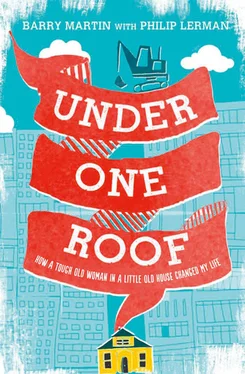I was never much of a reader, myself. There weren’t a whole lot of books around my house, growing up. I guess if I was going to school today they would have diagnosed me with attention deficit disorder, because I could never really focus on reading or anything like that. But as it was, I muddled through. I never even watched a lot of movies, to tell you the truth. Take me to a movie theater and I’d be asleep in fifteen minutes. Just couldn’t focus on it. But I did watch a few movies with Edith. She had tons of tapes all around this room as well, all movies from the forties and fifties. Lots of Bette Davis, lots of Sherlock Holmes. A lot of Greta Garbo, too: Grand Hotel , Anna Christie , Ninotchka . Somebody told me they thought Edith was a little like Garbo, holed up here in this little 106-year-old house in a shabby section of Seattle – but they had it wrong.
Edith didn’t want to be alone.
I was nervous, that first day on the job, walking up to her house. I’d heard so much already. At first I hadn’t been paying too much attention. I’m not that much of a reader, as I mentioned, and I hadn’t seen any of the articles in the paper, or heard about how the local newspaper reporters were all scared of Edith because she’d chase them away whenever they got within ten feet of her. In fact, when I got the job as construction superintendent for the shopping mall project, my wife asked me, “Oh, is that the one where the old lady won’t move?” And I said no, because I was sure I would have heard about it.
But when I mentioned it to the guys I worked for, they told me that yes, they had this stubborn old lady, like a little bulldog with wire-framed glasses, holding up the whole works. They’d gotten every other inch of the property they wanted, basically a city block square, except for this one little ramshackle house. Now they were having to build around it. And if anyone tried to talk to her, she’d more likely bite their head off than give them the time of day.
The first time I looked at the architect’s drawing, I saw the tiny rectangle that was cut out where Edith’s house stood. Later, the owners of the project and I talked it over, and we decided to put some steel embeds in the side walls facing Edith’s house, big galvanized steel plates with metal studs that go back and tie into the concrete. If she wound up selling, we could tear down her house and build across by welding beams to those embeds – basically filling in the little rectangle. And if she didn’t, well, I had perfectly good plans for building around her. To me, it was a construction job, and a pretty big one at that. I didn’t really care one way or the other.
The wheels had all got set in motion about a year earlier, back in the spring of 2005. I had worked for one construction company for almost ten years. For a while, there was a ton of work. Up here in Seattle, we really reaped the benefit of the dot-com boom even more than people know. I was a project superintendent, meaning I was basically in charge of all the people and subcontractors on a big project, such as an office building. It was the kind of thing that you figured, well, this is what my life is gonna be, and I’ll retire with this company. And you feel pretty good about it.
Then the dot-coms all went down and things got strange. There was a glut of office space, so the banks started pulling the plug on any project with office space in it. There just wasn’t enough work to go around. The company I worked for finally went out of business. I went to work for another fellow, building assisted-living facilities.
I wouldn’t know until later how ironic that was. When it became my whole life’s work just to keep one old lady out of them.
The boss was a good person to work for; the firm was small, and I was given a lot of autonomy, so it was easy to get things done. I was happy just to have landed on my feet, given how tough things were. But that spring, all the guys from my old company, the one that went out of business, got involved with another firm, called Ledcor. The owner of the old company came to run Ledcor’s Seattle office, and the old operations manager came on board, and the business-development guy, and their best project manager. Then they called me to come join the party.
I loved working with that crew. They were nice guys, and they really cared about you. They had this project they wanted me to do, and – not to put too fine a point on it – they started hounding me. Hounding me in a nice way, of course. But I knew what they were doing. The first calls came from the project manager, a great guy named Roger Wagner. Roger wouldn’t tell me too much about the job – just that it involved a whole city block, and that once that was done, there were one or two other blocks, and by the way, this Ledcor was a great place to work.
See, that’s how it works: he’s sticking the bait out there and waiting to see how hard you’re sniffing. Then if you’re interested, he’ll feed you the bait and reel you in. I knew what he was doing – and he knew that I knew – so it was all very jovial. But at the same time, I was a little intrigued, because you never know what’s going to happen tomorrow so you never slam the door on anything.
The next one to call me was the operations manager. He was also giving it the soft sell, because nobody wanted to seem too eager. So we all went around it for a month or two, until they finally gave me the are-you-in-or-are-you-out call.
It was a tough decision. These guys were like family to me, but I hated leaving the job I had. I don’t like leaving things without a reason. I need to be able to say, well, this bothers me or that bugs me. But there was nothing wrong with where I was. I looked for a reason to justify the move, and all I could come up with was, well, these guys have a better retirement program or a better bonus-potential program, or they’re large enough that there is room for me to grow. But I knew that at that point I was just making excuses to do what I already knew I wanted to do.
So I said, I’m in.
The project was to build a shopping mall. A developer, the Bridge Group, had purchased most of a city block in Ballard, a nice, sleepy waterfront neighborhood just over a short bridge from downtown Seattle. But the project got stalled off just as I came on board, so they had me working on another project in the meantime. That Christmas, while I was still waiting to get started down in Ballard, a columnist for The Seattle Times apparently wrote about an odd phenomenon that went on down near the site. I didn’t read about it at the time, but I heard about it later: At night, after the bars closed, lots of people with no place else to go would park their cars on the side streets, and kind of live in them. The columnist, a guy named Danny Westneat, wrote that one night he counted forty-one live-in vehicles parked in a couple-block area – right in the neighborhood where I was going to be building the mall.
In the article he quoted Edith, saying she thought that maybe two hundred or three hundred of these itinerants camped out in this rolling car colony on the weekends. You’d think the locals would be pretty furious that the cops were letting this go on, but her attitude was “What can you do? They don’t have any money, so where can they go? The way I see it, if they don’t bother me, I don’t bother them.” Seemed like a pretty philosophical approach. I didn’t see that article until much later, but when somebody did show it to me, I was kind of surprised – you don’t expect someone with a reputation for being so ornery and crotchety to be so accepting of stuff like that.
Sometimes people aren’t who you think they are.
It was spring of 2006 when most of the permits cleared and we could finally get rolling. I got down there early that first day, to do what I always do when I start a job. I began by going around to all the neighbors on the surrounding streets, introducing myself to people, making sure they had my cell phone number in case there were any problems. I always feel like it’s good to get that up front first. You can’t pretend to do a big job like this right down the block from someone and not have them notice, or act like you’re never gonna cause them a problem. But you can let them know you care enough to hear about what you’re doing that’s annoying folks, and you’re willing to meet them halfway. I feel like it’s my responsibility. If someone was doing that to me, I’d expect the same.
Читать дальше











